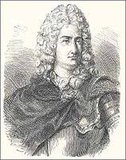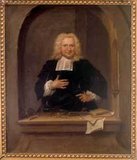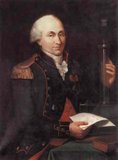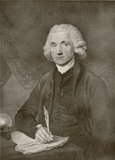The history of the development of electrodynamics. Electrostatics
In the last post , there was a whole discussion about whether such articles are necessary here, but since I had already prepared a continuation by this point, I decided to post it.
In continuation of the recently started topic about the history of the development of electrodynamics, let's talk now about electrostatics.
')
So, Hilbert separated the magnets from substances that could electrify and attract small particles to themselves (for example, amber and glass). The development of electrostatics, that is, the science of the interaction of stationary charged particles, began with this. At that time, the nature of the interaction was not known either between the magnets or between charged bodies. Hilbert suggested that the bodies that can electrify contain some “juices”, and during friction they heat up or are still somehow excited, due to which evaporation starts to emanate from electrified bodies, which also attracts the surrounding objects. That is, in essence, Hilbert suggested that electrified bodies interact not by themselves, but through some kind of matter. This theory will later be called the theory of short-range action. In contrast, there was a long-range theory, according to which bodies interact directly with each other. Newton was an active supporter of the theory of long-range action, his theory of world wideness seemed to be a weighty argument for the benefit of long-range action. Newton criticized Hilbert's theory of the “evaporation” of electrified bodies:
In the future, before Faraday and Maxwell, the long-range theory will be considered correct, but attempts to explain it will not lead to anything. However, immediately after Gilbert, many were interested in his theory. True, again, no one could explain exactly how "evaporation" affect the body.

Otto von Gerike
The first to notice that electrified bodies not only can be attracted, but also repel each other, Niccolò Cabo (1585-1650). Later, in 1660, Otto von Gerike (1602 - 1686), a German physicist, manufactured an electric machine. It was a sulfur ball rotating on an iron axis. If you put your hand to the rotating ball, it electrified and began to jump sparks. Gerike noted that the ball attracts light bodies, and having touched the ball, they immediately repelled and did not attract to it until they touched any other body. He also noticed that an electrified ball glows in the dark.

Charles Francois Dufet
After accumulating a lot of facts about charged bodies, these facts needed to be somehow explained. In 1733, Charles-Francois Dufet (1698 - 1739) proposed the existence of two kinds of electricity - glass and resin. He divided the substances capable of electrifying into two classes: the materials from the first class gave “glass” electricity (this kind of electricity was so named because glass fell here), the substances of the second class gave “resin” electricity (amber got here). Charged bodies from different classes attracted, while charged bodies from the same class repelled.

Peter van muschenbrook
12 years later, in 1745, after this work, Dufet in the Dutch city of Leiden, Peter van Muschenbruck (1692 - 1761), together with his friend Küneus (according to other information, his student) invented the first-ever capacitor, which was named after - Leiden Bank. Simultaneously with Mushenbruck, the same scientist was proposed by the German scientist Kleist (1700 - 1748), therefore the Leyden jar was sometimes called the Kleist jar. The device of the Leyden jar was quite simple - it was a glass vessel pasted on the outside with tin sheet, it was the outer lining. To create a second, inner lining, a can either filled with water or covered the inner surface of the can with tin. The wire stuck through the mouth of the jar acted as a contact for the inner lining. In the first experiments, the capacitor had no external lining, and in its quality were the hands of the experimenter. It was after the impact of the current from such a Leyden jar without an external lining of Küneus that he learned that the capacitor is working. :) Leiden banks could accumulate a charge up to a micro-pendant (but at that time such a thing as Coulomb did not exist yet, and Coulomb itself was then 9 years old). Leiden Bank played a very important role in the development of electricity and prompted further research. By the way, it was Mushenbruck who first connected the Leyden banks to the battery in order to increase their total capacity.

Benjamin Franklin
Almost immediately after the invention of the capacitor, Benjamin Franklin, the same American politician who participated in the creation of the American constitution, comes on the scene. He did an unusual amount of research for electricity. First, he proposed his theory instead of Dyufe's theory of two kinds of electricity. Franklin suggested that electricity can be of only one type, and the division of materials into two classes is due to an excess or deficiency of this same electricity. And it was Franklin who proposed to designate charged bodies with “+” or “-” signs. Thus, it turned out that “glass” electricity was designated by a plus, and tar - by minus. If he marked them the other way around, we would now be easier in the sense that by agreement the current flows from plus to minus (from the place of excess “electricity” to the place where there is not enough), according to Franklin's notation, it turns out that an electron ( of which then, of course, they still did not guess) has a negative charge, therefore, they run from minus to plus. Thus it turns out that the current flows in the direction opposite to the movement of electrons, the carrier of that current itself. Franklin did not know about electrons then, of course, but because of this designation, there is now such a small confusion with the direction of the current and the direction of movement of the current carriers - electrons.
He also introduced such concepts as "battery", "capacitor", "conductor", "charge", "discharge". In addition, Franklin actively studied lightning and found that atmospheric electricity and static electricity, obtained by friction, is one and the same electricity. Even on the bust of Franklin, sculptor A. Goudon inscribed in Latin: “He took lightning from heaven and power from tyrants”, the phrase itself belongs to Franklin's friend and biographer Ann Robert Jacques Turgot (1727 - 1781). Franklin established in 1752 that lightning is nothing more than an electrical discharge. He also invented the lightning rod and grounding. He also first began to use an electric spark to explode gunpowder. And it was Franklin who explained the principle of the Leyden jar and what role the dielectric plays in it (of course, as far as it was possible at that time). But, to be honest, Newton had analogies between spark and lightning, he wrote that electrical sparks resemble lightning to him.

Charles Augustin de Coulomb
At this point, scientists tried not only to describe and explain electricity, but also somehow measure the charges and the strength of their interaction. In the latter succeeded Charles Augustin Coulon (1736 - 1806). You probably already understood that it will be a question of the law that bears his name. He formulated his law in one of seven memoirs, which were published from 1785 to 1789. Let me remind you that this law says:

Henry Cavendish
In fact, Coulomb was more interested in the devices he was engaged in than in electrostatics itself. He wanted to make the torsion scales as accurate as possible, and at the same time with their help he measured the interaction force between the charges. He also introduced the concept of magnetic moment and polarization of charges. The fact that the interaction force between the charges is proportional to 1 / r ^ 2 was established in 1771 by the English physicist Henry Cavendish (1731-1810), but did not publish his discovery and experiment, with which he made such a conclusion.

Joseph priestley
True, both Coulomb and Cavendish only confirmed the assumption made by Joseph Priestley that the interaction force between the charges is inversely proportional to the square of the distance between them. Priestley was not firmly convinced of his assumption and based it on the assumption that the charges interact in the same way as the bodies in the law of attraction. But it was Coulomb who brought the law to its logical end by introducing into it a dependence on the magnitude of the charge.
It is also interesting that Coulomb did not accept the theory of Franklin about the existence of only one kind of electricity, but adhered to the theory of Dyuf. Coulomb imagined electricity in the form of two different liquids, and the interaction between charged bodies explained the interactions of the particles of these liquids.
In the same way, Coulomb imagined the action of magnets, explaining their action by “magnetic fluids”. But then, if two such “magnetic fluids” flow in each body (since the magnet has two poles), it turns out that they could be separated, but Coulomb argued that this is impossible, leading to the proof that the magnet cannot get only the north or south pole, and if you break it, you get two magnets with two poles.
At this point, let's stop, in the next part we'll talk about the discovery of galvanic electricity.
Links to Wikipedia, from where I took the portraits, I will not give :)
This post is on my blog.
In continuation of the recently started topic about the history of the development of electrodynamics, let's talk now about electrostatics.
')
So, Hilbert separated the magnets from substances that could electrify and attract small particles to themselves (for example, amber and glass). The development of electrostatics, that is, the science of the interaction of stationary charged particles, began with this. At that time, the nature of the interaction was not known either between the magnets or between charged bodies. Hilbert suggested that the bodies that can electrify contain some “juices”, and during friction they heat up or are still somehow excited, due to which evaporation starts to emanate from electrified bodies, which also attracts the surrounding objects. That is, in essence, Hilbert suggested that electrified bodies interact not by themselves, but through some kind of matter. This theory will later be called the theory of short-range action. In contrast, there was a long-range theory, according to which bodies interact directly with each other. Newton was an active supporter of the theory of long-range action, his theory of world wideness seemed to be a weighty argument for the benefit of long-range action. Newton criticized Hilbert's theory of the “evaporation” of electrified bodies:
“Let him explain to me how an electrified body during friction can emit radiation, so sparse and elusive and at the same time so powerful that its emission, without causing a noticeable reduction in the weight of an electrified body, and expanding into a sphere whose diameter exceeds two feet, however, remains able to excite and hold a copper or gold plate over a foot from an electrified body? ”
In the future, before Faraday and Maxwell, the long-range theory will be considered correct, but attempts to explain it will not lead to anything. However, immediately after Gilbert, many were interested in his theory. True, again, no one could explain exactly how "evaporation" affect the body.

Otto von Gerike
The first to notice that electrified bodies not only can be attracted, but also repel each other, Niccolò Cabo (1585-1650). Later, in 1660, Otto von Gerike (1602 - 1686), a German physicist, manufactured an electric machine. It was a sulfur ball rotating on an iron axis. If you put your hand to the rotating ball, it electrified and began to jump sparks. Gerike noted that the ball attracts light bodies, and having touched the ball, they immediately repelled and did not attract to it until they touched any other body. He also noticed that an electrified ball glows in the dark.

Charles Francois Dufet
After accumulating a lot of facts about charged bodies, these facts needed to be somehow explained. In 1733, Charles-Francois Dufet (1698 - 1739) proposed the existence of two kinds of electricity - glass and resin. He divided the substances capable of electrifying into two classes: the materials from the first class gave “glass” electricity (this kind of electricity was so named because glass fell here), the substances of the second class gave “resin” electricity (amber got here). Charged bodies from different classes attracted, while charged bodies from the same class repelled.

Peter van muschenbrook
12 years later, in 1745, after this work, Dufet in the Dutch city of Leiden, Peter van Muschenbruck (1692 - 1761), together with his friend Küneus (according to other information, his student) invented the first-ever capacitor, which was named after - Leiden Bank. Simultaneously with Mushenbruck, the same scientist was proposed by the German scientist Kleist (1700 - 1748), therefore the Leyden jar was sometimes called the Kleist jar. The device of the Leyden jar was quite simple - it was a glass vessel pasted on the outside with tin sheet, it was the outer lining. To create a second, inner lining, a can either filled with water or covered the inner surface of the can with tin. The wire stuck through the mouth of the jar acted as a contact for the inner lining. In the first experiments, the capacitor had no external lining, and in its quality were the hands of the experimenter. It was after the impact of the current from such a Leyden jar without an external lining of Küneus that he learned that the capacitor is working. :) Leiden banks could accumulate a charge up to a micro-pendant (but at that time such a thing as Coulomb did not exist yet, and Coulomb itself was then 9 years old). Leiden Bank played a very important role in the development of electricity and prompted further research. By the way, it was Mushenbruck who first connected the Leyden banks to the battery in order to increase their total capacity.

Benjamin Franklin
Almost immediately after the invention of the capacitor, Benjamin Franklin, the same American politician who participated in the creation of the American constitution, comes on the scene. He did an unusual amount of research for electricity. First, he proposed his theory instead of Dyufe's theory of two kinds of electricity. Franklin suggested that electricity can be of only one type, and the division of materials into two classes is due to an excess or deficiency of this same electricity. And it was Franklin who proposed to designate charged bodies with “+” or “-” signs. Thus, it turned out that “glass” electricity was designated by a plus, and tar - by minus. If he marked them the other way around, we would now be easier in the sense that by agreement the current flows from plus to minus (from the place of excess “electricity” to the place where there is not enough), according to Franklin's notation, it turns out that an electron ( of which then, of course, they still did not guess) has a negative charge, therefore, they run from minus to plus. Thus it turns out that the current flows in the direction opposite to the movement of electrons, the carrier of that current itself. Franklin did not know about electrons then, of course, but because of this designation, there is now such a small confusion with the direction of the current and the direction of movement of the current carriers - electrons.
He also introduced such concepts as "battery", "capacitor", "conductor", "charge", "discharge". In addition, Franklin actively studied lightning and found that atmospheric electricity and static electricity, obtained by friction, is one and the same electricity. Even on the bust of Franklin, sculptor A. Goudon inscribed in Latin: “He took lightning from heaven and power from tyrants”, the phrase itself belongs to Franklin's friend and biographer Ann Robert Jacques Turgot (1727 - 1781). Franklin established in 1752 that lightning is nothing more than an electrical discharge. He also invented the lightning rod and grounding. He also first began to use an electric spark to explode gunpowder. And it was Franklin who explained the principle of the Leyden jar and what role the dielectric plays in it (of course, as far as it was possible at that time). But, to be honest, Newton had analogies between spark and lightning, he wrote that electrical sparks resemble lightning to him.

Charles Augustin de Coulomb
At this point, scientists tried not only to describe and explain electricity, but also somehow measure the charges and the strength of their interaction. In the latter succeeded Charles Augustin Coulon (1736 - 1806). You probably already understood that it will be a question of the law that bears his name. He formulated his law in one of seven memoirs, which were published from 1785 to 1789. Let me remind you that this law says:
“The force of interaction between two pointless stationary charged bodies in a vacuum is directed along the straight line connecting the charges, is directly proportional to the product of the charge modules and inversely proportional to the square of the distance between them.”

Henry Cavendish
In fact, Coulomb was more interested in the devices he was engaged in than in electrostatics itself. He wanted to make the torsion scales as accurate as possible, and at the same time with their help he measured the interaction force between the charges. He also introduced the concept of magnetic moment and polarization of charges. The fact that the interaction force between the charges is proportional to 1 / r ^ 2 was established in 1771 by the English physicist Henry Cavendish (1731-1810), but did not publish his discovery and experiment, with which he made such a conclusion.

Joseph priestley
True, both Coulomb and Cavendish only confirmed the assumption made by Joseph Priestley that the interaction force between the charges is inversely proportional to the square of the distance between them. Priestley was not firmly convinced of his assumption and based it on the assumption that the charges interact in the same way as the bodies in the law of attraction. But it was Coulomb who brought the law to its logical end by introducing into it a dependence on the magnitude of the charge.
It is also interesting that Coulomb did not accept the theory of Franklin about the existence of only one kind of electricity, but adhered to the theory of Dyuf. Coulomb imagined electricity in the form of two different liquids, and the interaction between charged bodies explained the interactions of the particles of these liquids.
In the same way, Coulomb imagined the action of magnets, explaining their action by “magnetic fluids”. But then, if two such “magnetic fluids” flow in each body (since the magnet has two poles), it turns out that they could be separated, but Coulomb argued that this is impossible, leading to the proof that the magnet cannot get only the north or south pole, and if you break it, you get two magnets with two poles.
At this point, let's stop, in the next part we'll talk about the discovery of galvanic electricity.
Links
- Terletsky Ya.P., Rybakov Yu.P. “Electrodynamics”, 1990
- Whitteker E. “The history of the theory of ether and electricity. Classical theories ”, 2001 (the original was written as much in 1910).
- V. Kartsev “The Adventures of Great Equations”.
Links to Wikipedia, from where I took the portraits, I will not give :)
This post is on my blog.
Source: https://habr.com/ru/post/55836/
All Articles